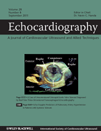Effect of Food Intake on Commonly Used Pulsed Doppler and Tissue Doppler Measurements
Abstract
Objective: This study evaluates the effect of food intake on commonly used pulsed Doppler and tissue Doppler measurements. Methods: Twenty-three healthy subjects aged 25.6 ± 4.5 years were investigated. A wide selection of pulsed Doppler and tissue Doppler variables were measured before a standardized meal as well as and 30 and 110 minutes afterwards. Results: The following variables increased significantly (P < 0.05) 30 minutes after food intake: left ventricular stroke volume, left ventricular cardiac output, left ventricular outflow velocity–time integral, peak of early diastolic (E) and late diastolic (A) mitral flow velocities, pulmonary vein peak velocities in systole (S) and in diastole (D), S/D, pulsed tissue Doppler peak systolic velocities, and late diastolic velocities. Deceleration time of E-wave decreased significantly (P < 0.05). The change in measured variables between fasting and 30 minutes after the food intake ranged from 7% to 28%. There were no significant (P > 0.05) changes in E/A, early diastolic tissue Doppler velocities (e’), and E/e’. Most, but not all variables returned to baseline values 110 minutes after food intake. Conclusions: This study shows that food intake affects several echocardiographic variables used to routinely assess diastolic function and hemodynamics. Further studies are warranted in older healthy subjects and in patients with various cardiac diseases to determine whether the findings are reproducible in such populations. (Echocardiography 2011;28:843-847)




